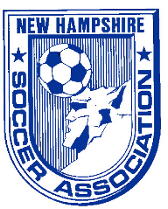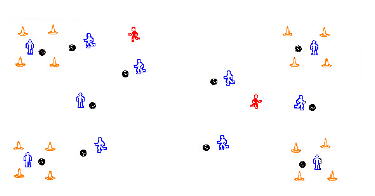
It is imperative that coaches get the parents involved. Not only are they are a major resource for your team, but the U-6 player still views their parents as the most significant people in their lives. A pre-season meeting should be held with the parents so that objectives and team policies can be addressed. Some topics that you may want to address at this meeting are:
6, 7, and 8 year old players are a bit more compliant than their U-6 counterparts. They will be able to follow 2 or 3 step instructions and are starting to have a good understanding about what it means to play a "game". They are also starting to cooperate more with their teammates. In fact, they now will recognize that they even have teammates by the fact that they occasionally, and I mean occasionally, will pass the ball to a teammate, on purpose. Often, they will repeat the phrase "I can't do that!", but, will quickly run to you to show you that they can, even when they only think that they can. Some other things that you can expect to happen during a season with this age group are:
Some of the players that are playing as a 7 year old have had two years of soccer experience and thus have already touched the ball a few thousand times in their lives. This, however, does not mean that these players are ready for the mental demands of tactical team soccer. True, they do have some idea of the game, but the emphasis still needs to be placed on the individual's ability to control the ball with his/her body. They are still there to have fun, and because some of the players may be brand new to the sport, it is imperative that activities are geared towards individual success and participation. Following are some more items that a coach of U-8 players should consider.
Here are some items that should be included in a U-8 training session:
WARM-UP: A brief warm-up is appropriate in order to get the players thinking about soccer and to prepare them physically for the time ahead. This should involve individual body activities that may or may not involve the ball. They can chase their ball as it is thrown by the coach, bringing it back with different parts of their body. Or, they can chase someone with their ball at their feet. Static stretching is also appropriate at this time, again, hopefully done with the ball. "Soccernastics" activities are very appropriate, like: dribbling the ball with the bottom of their feet, with their elbows, backwards, with the back of their neck while holding on to it; keeping the ball up with their thighs; keeping it up with their feet while sitting.
INDIVIDUAL OR SMALL GROUP ACTIVITIES: Follow the warm-up with some kind of individual activity, not a real 1v.1 game, but some kind of activity where players act as individuals in a game environment. An example would be a kind of tag game, or a game where players are trying to work with a partner or small group to obtain a goal. Keep players in motion at all times. Avoid having them wait on lines. Play games of "inclusion" (where everyone plays), instead of games where the "looser sits". Be creative. These players like "crazy" games with a lot of action.
PLAY THE GAME: Small sided soccer can be used to heighten intensity and create some good competition. Play 1v.1 up to 5v.5. Be creative. Play with 4 goals, or 2 balls. Play with or without boundaries. Perhaps play to emphasize a particular skill (can only dribble the ball over a goal line in order to get a point). Use cones if you don't have real goals. Keep players involved. Have more than one game going on at a time if necessary. Switch teams often, give everyone a chance to win. Also, it is important that every player has a chance to shoot on goal as often as possible.
WARM-DOWN & HOMEWORK: Finish the session with a warm down. Give them some more stretches to do with the ball. You may want to review what you started the session with. Also, give them some homework so that they practice on their own. Think of some ball trick that you would like to see them try to do, like, bounce it off their head, then thigh and then catch it. Can one player kick a ball to a partner and then back without it hitting the ground? It is important to finish on time. This is especially essential if the players are really into it. Stop at this point and you will get an enthusiastic return
Here is a game which involves both passing and dribbling that is fun and engages players quickly. Also, although primarily an individual exercise that allows for differences in ability level, if the players are ready, it can quickly become a cooperative game where players work together to solve a challenge.
THE GAME: Each player will need a ball. Player 'A' is "It" and is the only player to start with a ball. All the other players around the outside of the grided space.
Player 'A' dribbles and tries to hit the other players below the waist with the ball. When hit, that player gets a ball and joins player 'A'.
The game is over when all of the players have been caught.
The last player caught starts with the ball for the next game.
If you think the task will be too difficult for the one player to get another at the start of the game, start with 2 players being "It".
Encourage quick movements and sudden changes of direction to catch players off guard.
Encourage deceptive passing of the ball: look one-way and pass the other; use the outside of the foot.
Players not caught should run, jump, and use zig-zag movements.

Here is another game that emphasizes dribbling that is fun and challenging for players. Again, primarily, it is an individual game that could lend itself to small group cooperation if the players are ready.
THE GAME: Each player will need a ball, except those that have been designated as "It".
Players that are "It" need to carry a colored pinnie or flag in their hand.
Players with a ball try to dribble without being tagged. If they are, they exchange places with the "tagger" (The "tagger" hands the pinnie to the dribbler and takes their ball).
Dribblers are safe in one of the designated bases. Only one player is allowed in a base at a time. if a new player enters a base, the old player must leave the base.
Add "taggers" when the players find the game to be easy.
It seems about right to have one base for every 3 players, but, this number can be adjusted either way to make the game constantly interesting.
This game can also be played by only allowing the "tagger" to "get" someone by kicking their ball away, not just "tagging" the person.
Experiment with different combinations of "taggers" and bases to keep the players engaged.
Written by Jeff Pill, NHSA Director of Coaching. Special thanks to Dr. Thomas Fleck and the National Youth Coaching Staff, Bill Buren, Dr. David Carr, Dr. Ronald Quinn, Virgil Stringfield.